What's it like on Venus?
A lecture by Paul Doherty with Eric Muller
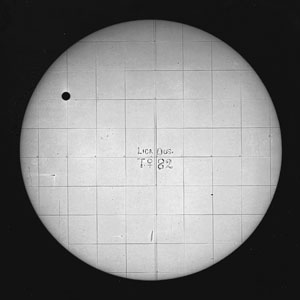
An image of the 1882 transit of Venus recorded at Lick
Observatory, California.
What's it like on Venus?
A lecture by Paul Doherty with Eric Muller

An image of the 1882 transit of Venus recorded at Lick
Observatory, California.
The Transit
On June 8, 2004 Venus will pass across the face of the sun as viewed from: Europe, Africa, the eastern United States and western Asia.
This will be the first transit since 1882, 122 years ago. That transit was photographed from Lick observatory. 147 images were taken of the transit on glass plates. These plates have been scanned and turned into an animation.
Animation of Venus Transit, Courtesy of Lick Observatory
The next transit will be June 6, 2012. Part of the transit will be visible from the western United States.
The pattern of transits is due to the almost perfect ratio between the length of the earth year and the Venus year. In the time it takes the earth to orbit the sun 8 times, Venus orbits almost exactly 13 times.
Math: Earth orbit 365.25636 days, Venus orbit 224.701 days.
8 * 365.25636 = 2922.05 days, 13 * 224.701 = 2921.11 days
In this 8 year period Venus passes between the earth and the sun 5 times.
Thus 8 earth years after Venus lines up between the earth and the sun, Venus will once again line up between the earth and the sun. The ratio isn't perfect however, so eight years after this Venus no longer passes between the earth and the sun and we have to wait over 100 years for it to happen again.
During the Transit of Venus in 1761 Venus was found to have an Atmosphere,. As Venus approached the sun it was seen to be surrounded by a glow as sunlight refracted through the atmosphere. During the same transit Venus was seen to have no moon.
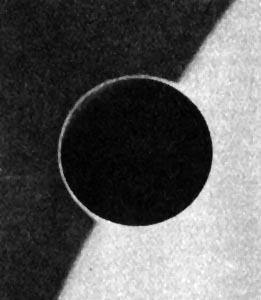
During the 1769 transit scientists measured more accurately than ever before the size of the solar system, in particular the Astronomical Unit. , they measured it to two significant figures. (Approximately 1.5 x 1011 m.)The astronomical unit measured during the 1882 transit was good to 3 significant figures, 1.49 x 1011m, it is now known to be, 149,597,870,691 +-30 m
The accuracy was limited by the "Black Drop effect" in which Venus appears to stretch out and remain connected to the edge of the sun.


Sketches of the "black drop effect" during the 1761 transit of
Venus. Photography had not been invented then.
Demo If you look at a brightly lit background like a white wall or a white car in sunlight through the slit between your thumb and finger as you squeeze them together without having them actually touch, you'll notice a black bridge connecting your thumb and finger. This bridge is related to the "black drop" effect. (image)
The "black drop" effect was originally thought to be due to the atmosphere of the earth or Venus, but it is not. Recent spacecraft observations made from outside the earth's atmosphere, of a transit of Mercury, which has no atmosphere, also show the "black drop" effect. The "black drop" is actually due to diffraction of light as it enters the aperture of the eye, telescope or camera.
You can learn a lot about transits of Venus on the Exploratorium Website.
The astronomical unit was originally found using parallax. Observe the object against a distant background from two different observing points a known distance apart. The object and the two observing points form a triangle, and trigonometry can be used to find the distance to the object. The parallax of Venus was measured against the sun from two observing points on earth to determine the astronomical unit. In addition, the parallax of Mars against the distant stars was measured.
Demo Stretch your arm out to full length and point at a distant object. Keep your left eye open and close or cover your right eye, then open your right eye and close your left eye, repeat. Notice how your finger seems to jump against the distant background. You are seeing parallax. Bring your finger closer to your face and notice how the distance it jumps against the background increases as you switch eyes.
Demonstrations
Venus is called Earth's twin because it is almost the same size as earth. The surface gravity of Venus is 0.88g you would weigh 12% less on Venus. If you weigh 150 lb. on earth you would weigh 132 pounds on Venus.
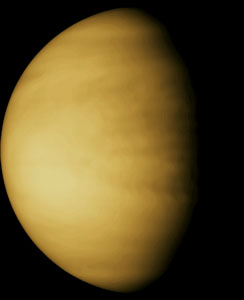
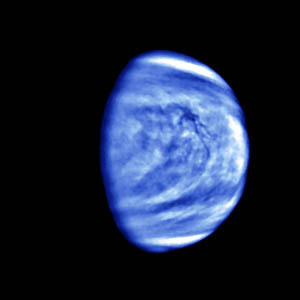
An image of Venus in ultraviolet light taken by the Galileo
spacecraft.
Most interesting images of Venus are taken using ultraviolet light. The clouds of Venus are bland when viewed in Visible light, but they have light and dark markings in the ultraviolet. It's a planet that a bee would enjoy watching since bees can see ultraviolet light. Image of a bee.
The atmosphere of Venus:
The atmosphere is dense
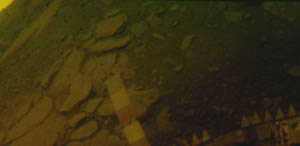
Venus has a hot dense atmosphere made of 95% carbon dioxide gas, plus nitrogen and argon.
Demo A balloon full of sulfur hexafluoride models a dense gas like the atmosphere of Venus. Pass it around the audience to let them feel the motion of a dense gas. Sulfur hexafluoride has a molecular weight of 146 amu, it is is 5 times denser than air, so the surface atmosphere on Venus would be ten times as dense as the gas in this balloon.
Demo (off the subject but fun) Breathe the sulfur hexafluoride and let the audience hear what it does to my voice. Sulfur hexafluoride makes my voice much deeper. This is the opposite of the effect of helium.
The atmosphere of Venus is about 50 times denser than the atmosphere of earth.
Here's the math. This is the result of the higher surface pressure which is 90 times the pressure at the surface of the earth combined with the high temperatures of Venus due to its closeness to the sun and its greenhouse effect. The atmosphere is less dense because of its temperature which is 750 K by the ratio of the earth temperature of 290 K to Venus' temperature or 290/ 750 about 1/3. It's also slightly denser because it is made of carbon dioxide with a molecular mass of 44 while the average of the earth's atmosphere is a molecular mass of 29. The exact final density of the Venus atmosphere is thus 90 * 290/750 * 44/29 = 53 times denser than the earth's atmosphere.
The air on earth is 1/800 as dense as water so the air on Venus is about 0.067 or 1/15, as dense as water. It's a lot denser than air but still less dense than water
. Dream Sequence Did you ever have those dreams where you are trying to run but the air is thick? that's what it would be like on Venus, with air conditioning of course.
Air so Thick it stops Meteorites.
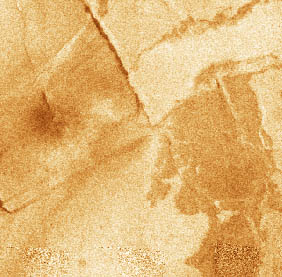
The air is so thick that it stops medium sized meteoroids from hitting the surface. The meteoroid is destroyed by the atmospheric forces, however an air blast continues down to strike the surface leaving dust free regions marking the air impact region. ( Venus images are made by radar, when the dust is blown off a region it becomes rougher and brighter in radar images.)
Demo Use an air toroid launcher from the Exploratorium Store (an Air Zooka) to send air blasts into the audience. (Shoot it at a hanging target made of tinsel?)
The Atmospheric Pressure is High
The Atmospheric pressure at the surface is 90 Atmospheres. 90 Bars.
This is the same pressure you would find 900 m (3000 feet) underwater. or under 130 m (520 feet) of steel. A steel rod the height of a 40 story building.
Demo One earth atmosphere Bar, a steel rod 1 inch on a side weighing 14.7 lb, such a rod is about 1.3 m long. Hold this in your hand to feel the pressure of the earth's atmosphere. (Optional Mars Bar 1.3 cm long.) I will not show a Venus Bar which would be 120 m long, the height of a 30 story building.
Demo Crush the can. The power of earth's atmospheric pressure. Boil a small amount of water, about 100 ml, in a 5 liter or 1 gallon can, remove the can from the heat, cap it tightly and the atmospheric pressure of earth will squeeze it into a wad of steel as the pressure inside is lowered. The water vapor which completely fills the can condenses into a liquid creating a vacuum inside the can.
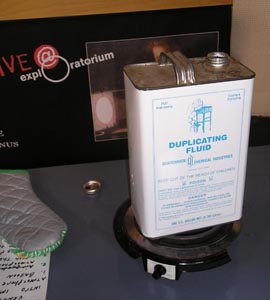
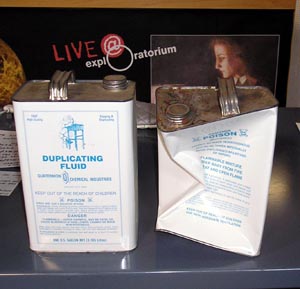
Left. Can with a small amount of boiling water on a
hotplate.
Right. Can crushed after being rmoved from the heat and capped.
The atmosphere is Hot
Venus is hot because it is close to the sun and also because the carbon dioxide in the atmosphere of Venus is a greenhouse gas which just about triples the surface temperature.
Temperature of Venus, 750 K, about 480 °C, or 900 °F.
How hot is it? The air on Venus is hotter than a self cleaning oven.
Demo Steam heated to 900 °F ignites paper. Fahrenheit 451.
Demo A Peep, a marshmallow easter candy, in a cold toaster oven (a regular oven will also work), turn the oven on to "broil." The temperature of the oven will increase to over 600 °F, still much cooler than the 900 °F surface ofVenus. Watch the peep as it swells up, begins to turn brown, liquifies into a puddle, and then blackens.

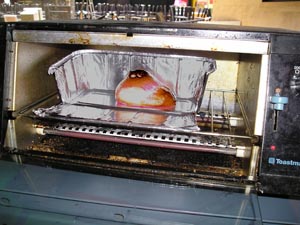
A "Peep" is a marshmallow easter candy. Place it in a cold oven.
Close the oven door and turn the oven to "broil." The peep will swell
up and turn brown, then melt into a puddle and turn black.
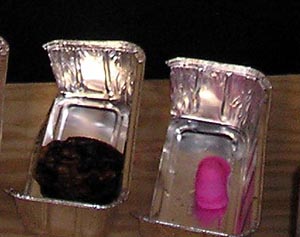
The end of the Peep, left, a puddle of blackened
carbohydrate.
It's hot enough on the surface of Venus to melt lead, or zinc.
Demo Use a torch to melt a zinc penny. The melting temperature of zinc is just under 700 K while the temperature at the surface of Venus is 750 K.
The atmosphere is made of carbon dioxide, CO2.
The atmosphere of Venus is 96% CO2 and 3.5 % N2.
Demo The smell of the Venus atmosphere, squirt CO2 from a 2 liter bottle of dry ice toward your nose. Sniff and smell the tangy smell of Venus. Or open a bottle of soda water and immediately smell the gas escaping from the neck of the bottle, it is carbon dioxide gas and smells like Venus.
Demo The taste of the Venus atmosphere, stick your tongue into a bottle of CO2 containing dry ice. (Don't touch the dry ice with your tongue!)
Normal fires fueled with wood or petrochemicals will not burn in a carbon dioxide atmosphere like that of Venus.
Demo Into a fish tank full of CO2 lower a candle and a lighter, optional a campstove. They all go out.
Demo However metal fires will burn in a CO2 atmosphere. Burn magnesium metal inside a block of dry ice.
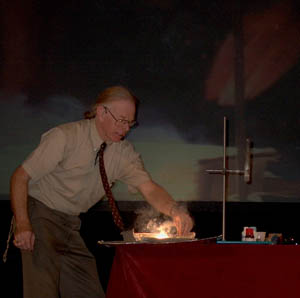
Clouds of Sulfuric Acid
The clouds of Venus contain droplets of sulfuric acid.
Demo Add sulfuric acid to sugar. Sugar, is a carbohydrate, such as C6H12O8, The sulfuric acid dehydrates the sugar, water, H2O, comes off as steam due to the heat released leaving behind a growing column of carbon foam. DO NOT do this exploration yourselves, it's dangerous, watch our video instead.
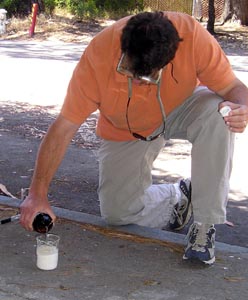

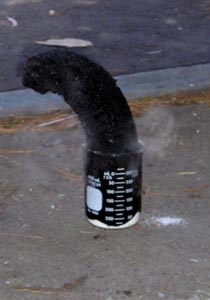
DO NOT DO THIS ACTIVITY! We show you this result so that you will not
need to do the exploration yourself. Eric adds concentrated sulfuric
acid to damp granulated sugar. After stirring it a while the mixture
steams and a black cylinder of carbon foam rises from the beaker. Do
not breathe the fumes rich in hot sulfuric acid laced
steam.
Story To protect spacecraft windows as they pass through the sulfuric acid clouds of Venus, engineers made windows for the spacecraft by cutting slices from a 40 carat diamond. The acid did not etch the diamond windows as it would have done to glass windows. The diamond was confiscated from a smuggler by U.S. Customs such diamonds are then made available for research.
Venus Unveiled
The Magellan spacecraft used radar to map Venus. Here is the surface beneath the clouds.
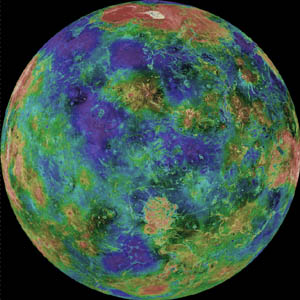
The blue areas are low altitude while the red areas are high. The surface of Venus is covered with basalt lava flows.
The surface is cratered uniformly. This is unlike
any other terrestrial planet. Which have more craters on older
surfaces and fewer craters on younger ones. It looks as if the
surface of Venus has been accumulating craters for 500 million years.
Either the entire surface was erased 500 million years ago, or
processes on Venus such as small regional lava flows uniformly erase
craters over the entire planet on a 500 million year timescale. This
is the classic question that faced geologists on earth, was earth
geology due to catastrophic changes or slow uniform changes. On earth
uniformitarianism was the correct answer, but on Venus catastrophism
may be correct.
Venus data
Venus is made of the same stuff as earth and in the same proportion, except it is missing water.
Cratering shows that the entire surface is about the same age, 500 MY: the question is is the surface created by uniformitarianism vs. catastrophism.
No meteoroids larger than 30m in diameter make it to the surface with enough energy to make a crater, they are destroyed or slowed by atmospheric forces.
High speed winds blow above 50 km altitude, 150 km/hr to the west. The upper atmosphere rotates 60 times faster than the planet.
Venus Orbit 0.723 AU, or 1.082 * 1011 m, sidereal period 224.701 earth days
Twice the solar intensity reaches the cloud tops as on earth.
Venus rotation, sidereal 243 earth days, solar 117 earth days. It takes longer for Venus to rotate once relative to the stars than it does to orbit once.
Earth and Venus line up every 583.92 days.
Venus rotates in 243.01 days, the rotation is opposite the direction of rotation of the earth. The sun rises in the west and sets in the east. Perfect synchronization with earth requires a period of 243.16 days.
Venus radius is 6.05 * 106 m, its mass is 0.815 earth's mass.
History of the AU: Before 1761 the value of the astronomical unit was not known to even 1 significant figure. In 1769 the value was refined to nearly 2 significant figures. In 1882 the value was known to nearly 3 significant figures and today it is known to nearly 11 significant figures, 149,597,870,691 +-30 m.
Today, astronomers search for planets orbiting distant stars by measuring the diminution of light from stars as planets pass between them and our line-of-sight. In the case of the planet orbiting the star HD 209458 they have found the spectrum from its atmosphere, which surprisingly contained oxygen.
|
Scientific Explorations with Paul Doherty |
|
25 May 2004 |